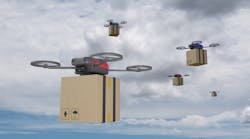Latest from 5G/6G & Fixed Wireless Access/Mobile Evolution
Delivery Drone Tech Demands Bandwidth
Being on the road, in the vast majority of cases, is a group activity. Your morning commute, even if you are the only passenger in your car, is something that you do with a myriad of other drivers. As a result, being on the road often means sitting in traffic and wasting time. In its 2021 Global Traffic Scorecard, INRIX reported that drivers in London lost an average of 148 hours as a result of traffic congestion during 2021. In Chicago, time lost to congestion was 104 hours. In New York, it was 102 hours.
For commuters, congestion means a lot of wasted time. For businesses that rely on US roads and highways for delivering their products, congestion means a lot of wasted money. According to Henry Petroski, author of “The Road Taken: The History and Future of America’s Infrastructure,” traffic congestion costs the US economy in excess of $120 billion annually.
Those brave enough to tackle the problems plaguing the traditional infrastructure in the US have discovered that solutions needed to properly address them are complicated and costly. A 2019 study revealed that keeping up with road maintenance in the US would cost more than twice the $105 billion currently spent on roads, tunnels, bridges, and other infrastructure components. The study also revealed that the US has fallen behind in its maintenance to the point that returning the infrastructure to an acceptable level would require six years of spending at that same level.
If the economics of tackling congestion were not enough of a discouragement, there are other statistics revealing that all the effort that goes into maintaining and improving the traditional infrastructure has actually made things worse. The advocacy organization, Transportation for America, reports that between 1993 and 2017, the US added more than 30,000 new freeway lane-miles of road in the largest 100 urbanized areas. The expansion marked a 42% increase. Despite the effort, traffic delays in those urbanized areas increased by 144%.
As long as eliminating congestion remains an elusive solution, avoiding congestion would seem to be a goal worth pursuing. In other words, those who are looking to streamline and economize the delivery process should look to a solution other than roads. That is where drones come into the picture. Drones, or unmanned aerial vehicles (UAVs), do not rely on the routes that frustrate traditional delivery systems. By taking to the skies, drones do away with the need for developing, maintaining, and optimizing key components of the traditional infrastructure systems.
A Smart Alternative
In November 2021, US President Joe Biden signed the Infrastructure Investment and Jobs Acts of 2021, putting into motion what the Whitehouse described as a “once-in-a-generation investment in our nation’s infrastructure and competitiveness”. The Act commits huge sums to maintaining the traditional delivery infrastructure. As outlined in the White House’s fact sheet on the matter, the Act looks to address problems with 173,000 total miles of US highways that need attention, as well as 45,000 bridges. The Act designates $110 billion for the work.
In addition, the Infrastructure Investment and Jobs Act provides funding to explore “advanced smart city or community technologies and systems” that could “improve transportation efficiency and safety”. The provision is part of a $500 million program known as the Strengthening Mobility and Revolutionizing Transportation (SMART) Grant Program, which will be overseen by a newly-established Department of Transportation Office of Multimodal Infrastructure and Freight. Drones are listed among the smart technologies that can be developed with funds from the SMART grants.
"In rural areas, those delivery points are often far apart, meaning delivery vehicles must spend more time on roads that, typically, are not highways. In urban areas, congestion often slows delivery speeds to a crawl. In any case, all the inefficiencies of the traditional delivery system come into play. Typically, 50% of a business’s delivery costs are wrapped up in the last mile."
While the SMART grant program suggests drone projects that support “traffic monitoring and infrastructure inspection” as the types of projects that could receive funding, it leaves the door open for any project that supports “transportation safety and efficiencies”. The program provides one sign that the boundaries of our infrastructure system need to be redrawn.
In addition, the Biden-Harris Administration’s Internet for All initiative released in May will invest $45 billion to provide affordable, reliable, high-speed Internet for everyone in America by the end of the decade. The initiative will be administered and implemented by the U.S. Department of Commerce’s National Telecommunications and Information Administration (NTIA).
The programs will build Internet infrastructure, teach digital skills, and provide necessary technology to ensure that everyone in America–including communities of color, rural communities, and older Americans–has the access and skills they need to fully participate in today’s society.
The Internet for All program launched with three Notices of Funding Opportunities:
- Broadband Equity, Access, and Deployment (BEAD) Program ($42.5 billion).
- Enabling Middle Mile Broadband Infrastructure Program ($1 billion); and
- State Digital Equity Act programs ($1.5 billion).
To participate in the BEAD Program, states and other eligible entities must submit a letter of intent and a planning funds budget, which will unlock $5 million in planning funds and allow states to begin creating their five-year action plan.
Last-Mile Problems
To truly appreciate the opportunities that drone tech provides, it is helpful to look at the issues surrounding last-mile delivery. Sometimes known as final-mile delivery, last-mile delivery is a term used to describe the final stage of the delivery process, when the product moves from the distribution center to the purchaser’s location. Some experts consider last-mile delivery the phase of the delivery process that is the most expensive and time-consuming.
When relying on the traditional delivery infrastructure, last-mile delivery is challenging for a number of reasons. Up until this point in the process, packages have been picked up, shipped, and delivered in bulk from manufacturer to shipping facility to warehouse with a focus on efficiency and speed. However, once the items are “out for delivery,” achieving efficiency and speed becomes challenging. The number of delivery points increases exponentially. In rural areas, those delivery points are often far apart, meaning delivery vehicles must spend more time on roads that, typically, are not highways. In urban areas, congestion often slows delivery speeds to a crawl. In any case, all the inefficiencies of the traditional delivery system come into play. Typically, 50% of a business’s delivery costs are wrapped up in the last mile.
Drones empower a future in which last-mile deliveries are managed without the use of roads or the vehicles that clog them. By establishing drone “vertiports” at warehouses or local retail facilities, delivery time and delivery cost is dramatically reduced.
Regarding the bandwidth needed to support drone technology, the Federal Communications Commission (FCC) conducted a study in late 2020 that concluded that Unmanned Aircraft System (UAS) operations, which would include a wide range of drones, could be supported by the 5030-5091 MHZ band. That bandwidth had been allocated for future satellite-to-aircraft and ground-to-aircraft communications links during the International Telecommunications Union’s World Radiocommunications Conference in 2012. The report also explored the potential of using the 960-1164 MHz band for supporting UAS operations but found “significant concern” related to the impacts such use could cause to aeronautical navigation operations that use that band.
Part of the beauty of drone infrastructure is its simplicity. In 2019, McKinsey and Company released a report that outlines the components necessary for an “air-mobility infrastructure”. There were only three–vertiports, charging stations, and receiving vessels. In essence, a drone infrastructure includes only the stopping and starting points.
The hundreds of thousands of miles of roadways that present a maintenance and management challenge are not necessary. Clearly, the drone delivery infrastructure is a much more manageable framework when compared with the needs of traditional delivery systems. And the price for the US government promises to be considerably less.
REFERENCES AND NOTES- Internet for All Face Sheet: https://www.internetforall.gov/sites/default/files/2022-05/Fact%20Sheet%20-%20IFA%20Launch_0.pdf
ABOUT THE AUTHOR
Dr. Shaun Passley holds numerous master’s degrees from DePaul University, Benedictine University, and Northwestern University, and has a PhD in Business Administration. In addition to founding ZenaTech, he is also Chairman & CEO of Epazz, Inc.–an enterprise-wide cloud software company–and the manufacturing company Ameritek Ventures. ZenaDrone is an entirely bootstrapped venture that is aiming to help the agriculture sector in Ireland close its emerging labor gap through automation. For more information, please email [email protected] or visit www.zenadrone.com. Follow them on Facebook: zenadroneofficial and LinkedIn: zenadrone and zenapay/about. You can also follow Shaun on LinkedIn: shaun-passley-phd-b2a0332a.
Drone Delivery Demands Bandwidth
Wing, which is a subsidiary of Alphabet, is already making such last-mile delivery efficiencies a reality. It began providing drone delivery services in April 2022 in the Dallas-Fort Worth area. It deploys its drones from makeshift vertiports set up in the parking lots of the businesses that it serves, which includes Walgreens. The drones deliver packages weighing up to 3.3 pounds at speeds of up to 70 miles per hour, lowering the package to the destination while hovering at a height of 23 feet above the ground. Before launching the service in Dallas-Fort Worth, Wing had already successfully completed more than 200,000 drone deliveries in other cities around the world.

Dr. Shaun Passley | Chairman and CEO, ZenaDrone
Dr. Shaun Passley holds numerous master’s degrees from DePaul University, Benedictine University, and Northwestern University, and has a PhD in Business Administration. In addition to founding ZenaTech, he is also Chairman & CEO of Epazz, Inc.–an enterprise-wide cloud software company–and the manufacturing company Ameritek Ventures. ZenaDrone is an entirely bootstrapped venture that is aiming to help the agriculture sector in Ireland close its emerging labor gap through automation. For more information, please email [email protected] or visit www.zenadrone.com. Follow them on Facebook: zenadroneofficial and LinkedIn: zenadrone and zenapay/about. You can also follow Shaun on LinkedIn: shaun-passley-phd-b2a0332a.




